What Is An SEO Strategy?
An SEO strategy is a plan of action to optimize a website's content to achieve higher rankings in search engine results and attract more organic traffic. It involves various techniques like keyword research, on-page SEO, technical SEO, and off-page SEO.
Why Is An SEO Strategy Important?
If you don’t have a specific blueprint to follow, you will end up ranking for the wrong keywords or with no rankings. Either way, this is not what you want.
I always tell my students and clients that doing SEO without a solid plan is like driving with your eyes closed. You still move forward, but it’s a matter of time before you hit a wall or engage in an accident.
8 Steps To Create An SEO Strategy
- Find Your Organic Competitors
- Analyze Your SEO Performance
- Work On Your Technical SEO
- Identify Your Target Keywords
- Plan Topic Clusters
- Optimize On-Page SEO
- Perform A Content Audit
- Focus On Link Building
1. Find Your Organic Competitors
This can be a surprising first step for many people, but I will explain below why this should be your starting point. It is more than certain that hundreds of websites are competing for the same keywords as you.
Some websites may have stronger domain authority, more related content, and higher Google trust. Can you compete with them?
- Is it worth spending time, money, and effort to outrank them?
- What is the potential benefit (in terms of traffic) if you get top positions for the keywords you are targeting?
Getting the right answers to the above questions will help you adjust your SEO strategy accordingly.
You can use an SEO tool to find out your organic competitors. Here is how to do it:
Use Semrush or your favorite tool and find out which websites rank in the top 5 positions of Google for the keywords you are targeting.
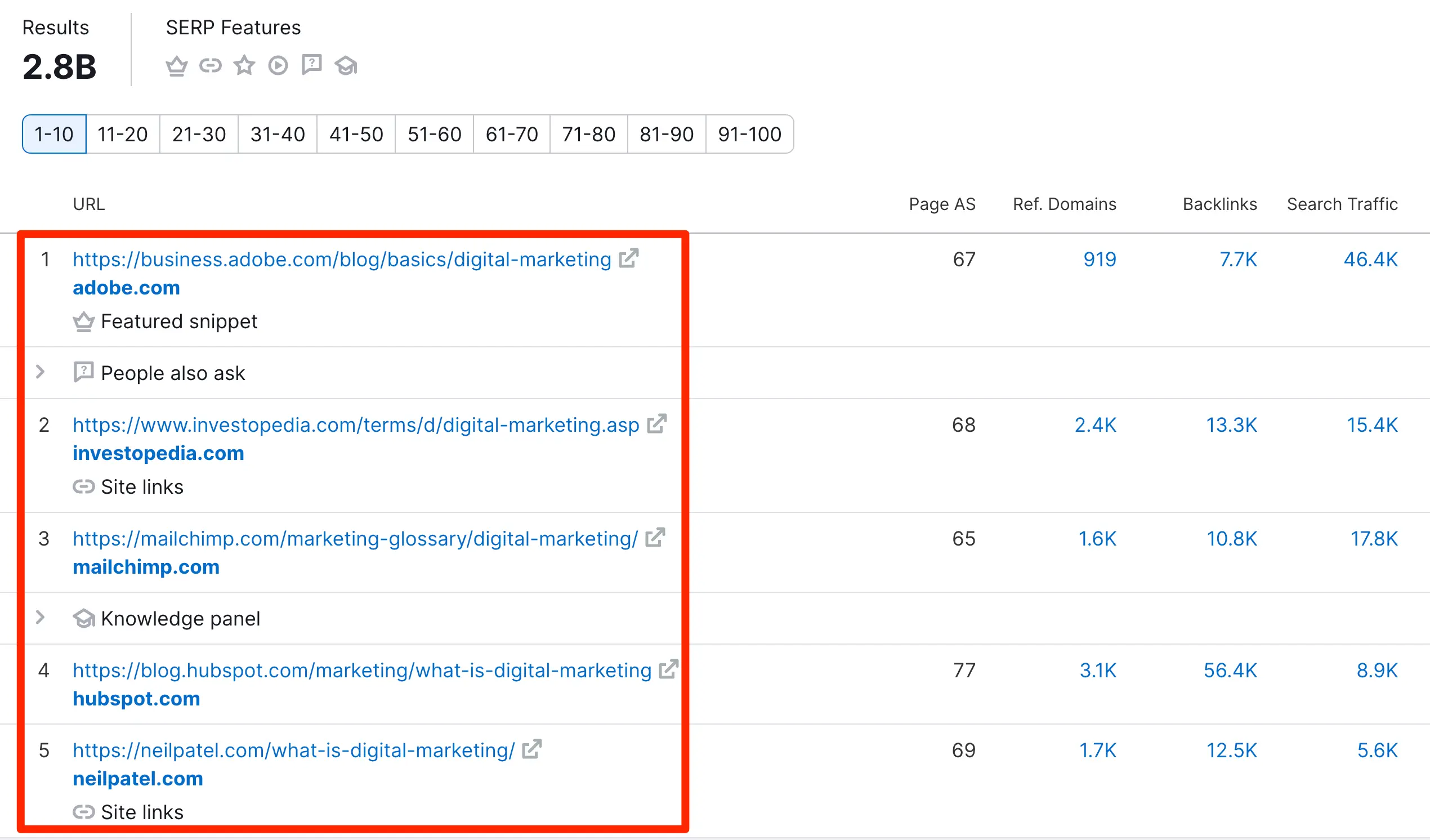
Find out the top-ranking pages of each website.
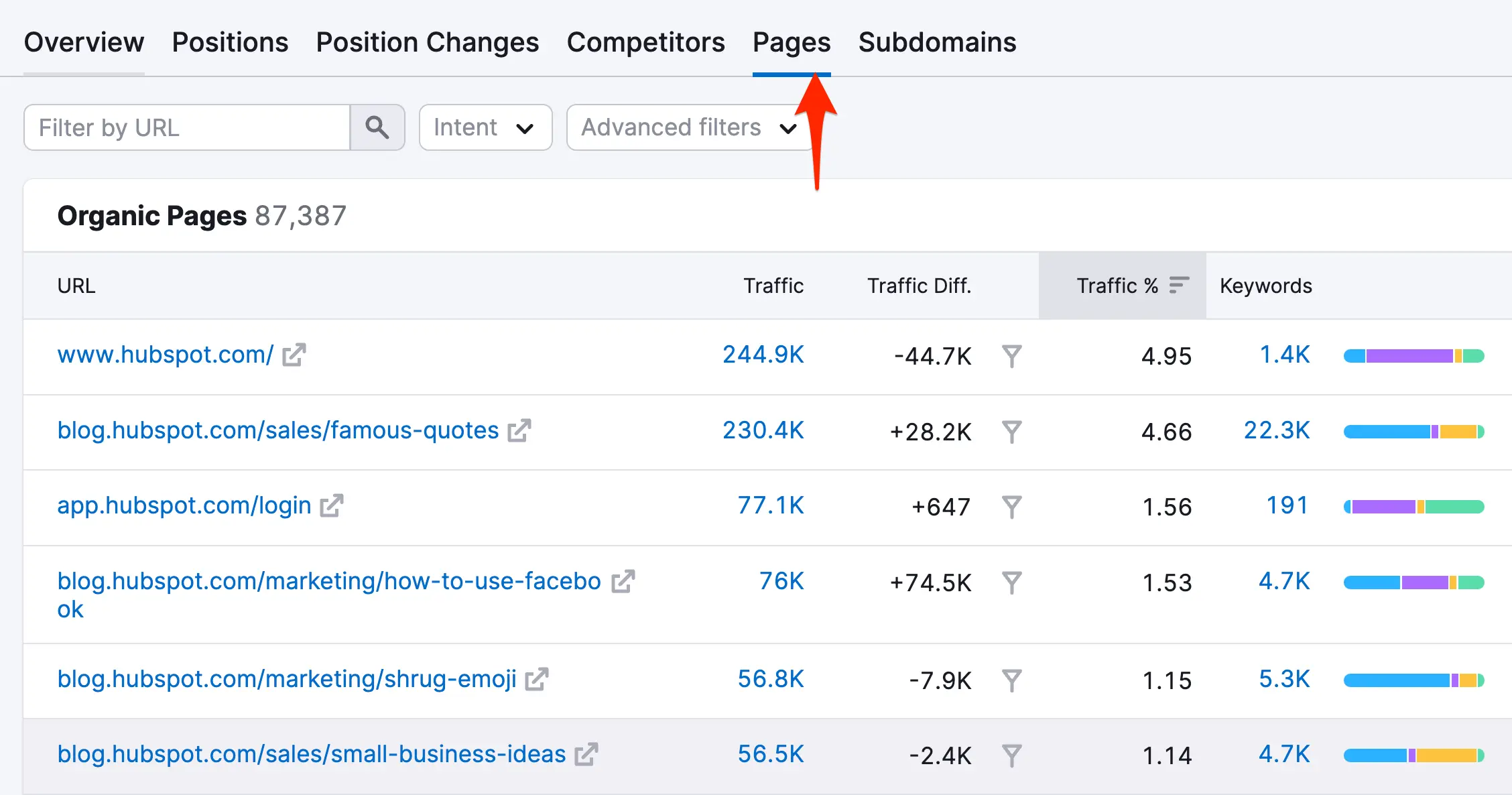
For each of their top-ranking pages, find out their most valuable keywords.

Analyze each ranking page and take note of the title of the page, description, type, and length of the content.
2. Analyze Your SEO Performance
Once you have a clear idea of who to compete with, the next step is to create a detailed report about your current SEO performance.
Knowing where you stand compared to your competitors will help you set realistic SEO goals.
At this stage, what you are looking for is answers to the following questions:
- How much SEO traffic do you get per day?
- What are your most popular organic landing pages?
- Which keywords drive traffic to your website?
- Your ranking position for the keywords you would like to improve.
You can get these answers through Google Analytics and The Google Search Console.
Go to Traffic Acquisition Report and look at Organic Search in Google Analytics. Look at the "Users" metric, which shows the total active users for the specified period.
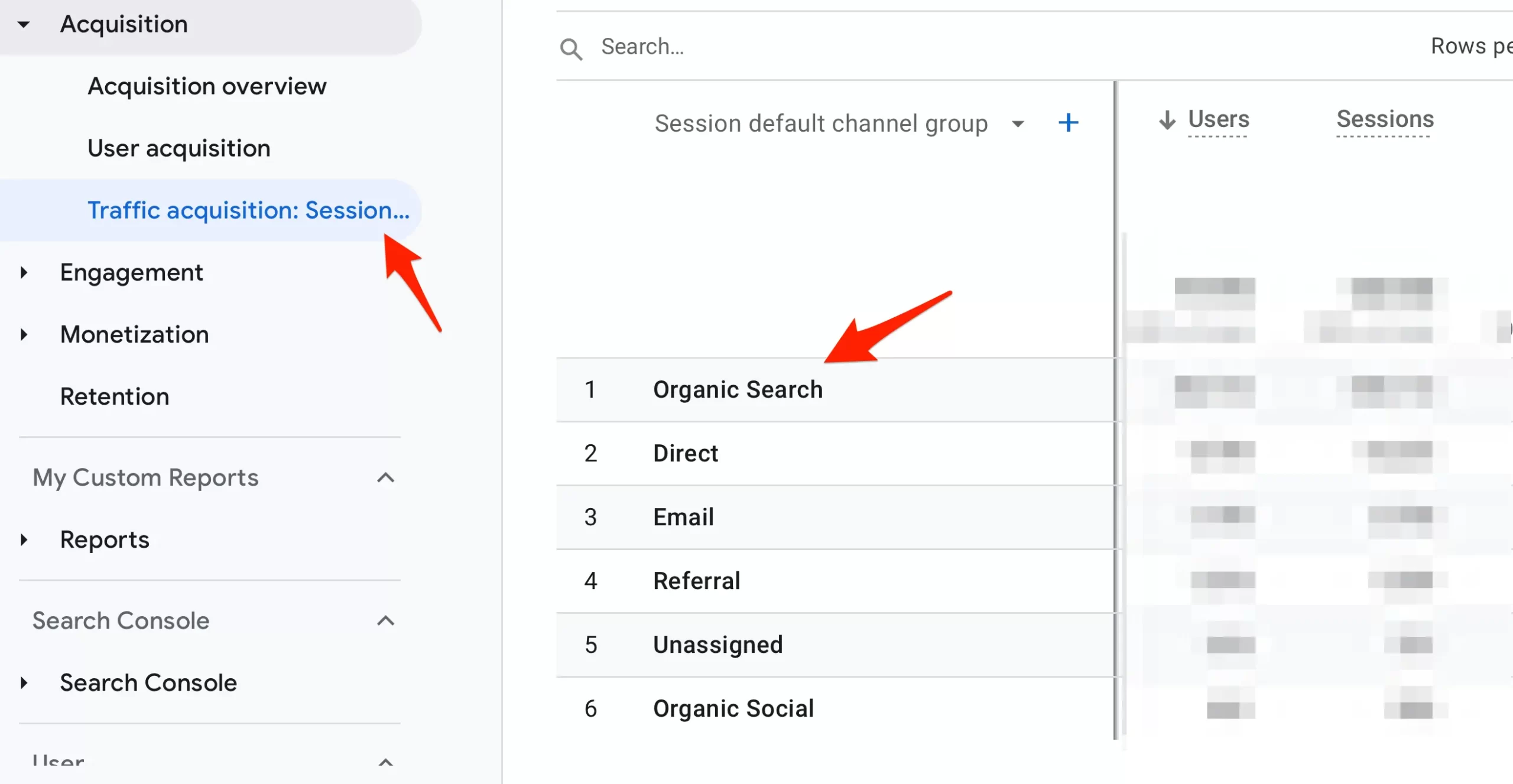
To find the most visited landing pages for Google organic traffic, go to Engagement > Landing Page.
Click the "+" and choose "Session Source / Medium".
Type "google / organic" in the filter to view visits from Google.
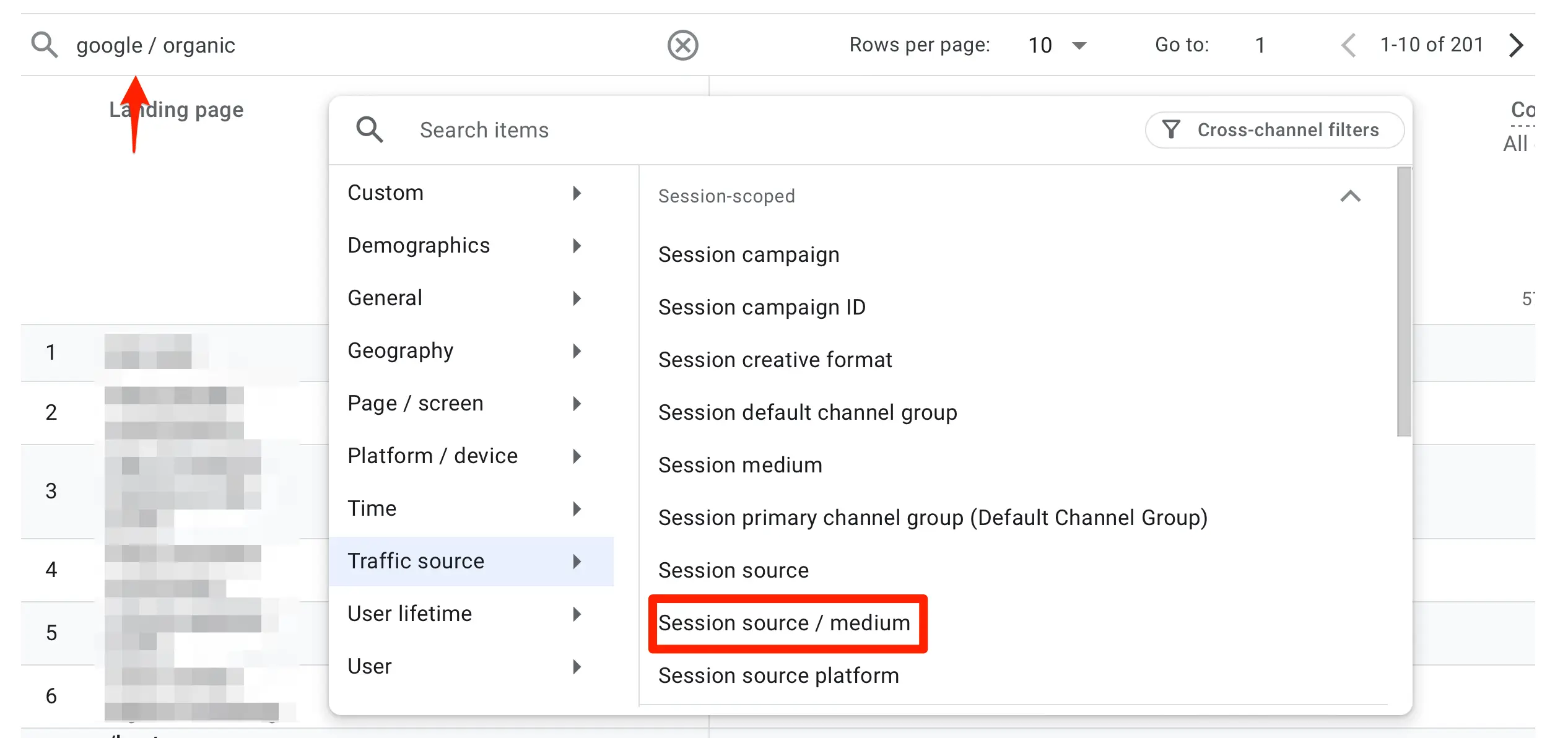
To see the keywords that generate traffic to your website from Google, view the Search Results report in Google Search Console. Use the Queries and Pages tabs to analyze your data by keyword and by page.
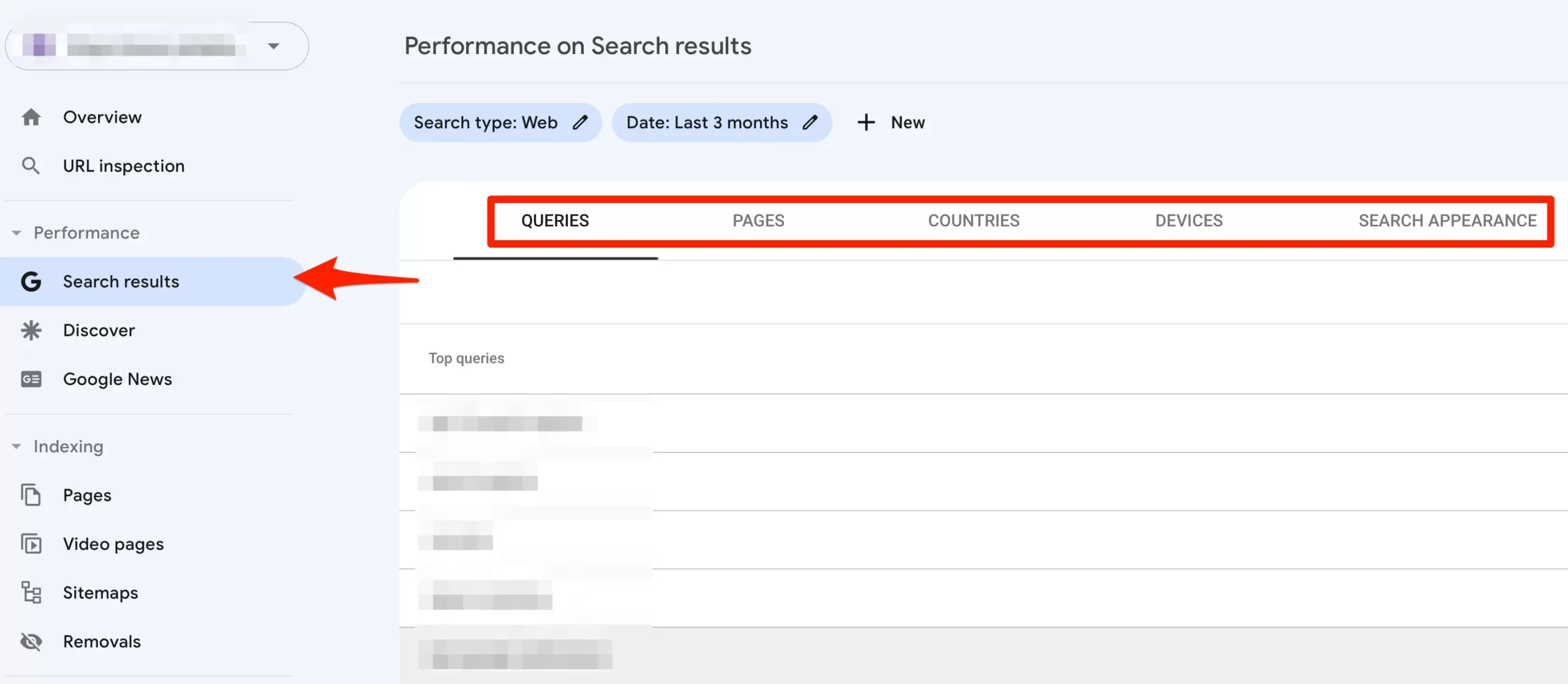
3. Work On Your Technical SEO
The next step is to get your hands dirty and start evaluating the technical SEO performance of your website by performing a technical SEO audit.
Through a technical SEO audit, you will ensure that search engines can index your content without any problems.
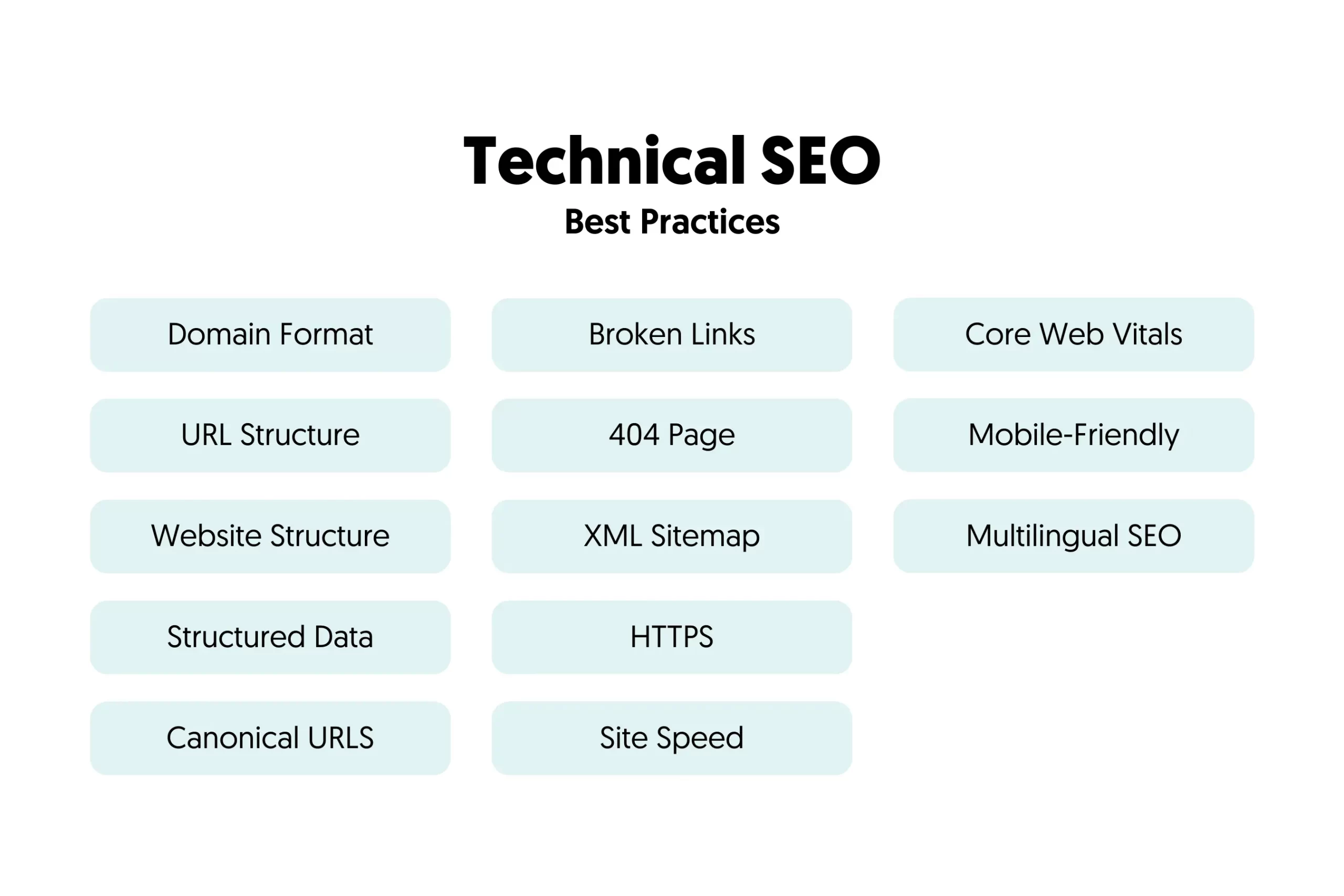
The most important things to check are:
- Crawl errors
- Robots.txt optimization
- XML Sitemap optimization
- Website Speed
- Core Web Vitals Scores
- Use of Canonical URLs
- Duplicate Content
- URL Structure
- Mobile-friendliness
- Correct use of HTTPS
- Schema Markup
Don’t worry. You don’t have to be technical to do an SEO audit. These three guides can help you pass this step successfully.
4. Identify Your Target Keywords
The next step is combining the information from the previous steps with a comprehensive keyword research analysis. Keyword research is a very important component of your SEO strategy.
Let me explain how this works.
In Step 1, you have identified which keywords bring traffic to your competitors, and in Step 2, you have identified which keywords bring traffic to your website.
It’s time to use this information and create your master keyword list. The list should include:
- The keywords that are essential for your business goals.
- Keywords that you didn’t know about but your competitors are getting traffic.
- Keywords you are already ranking.
In other words, your master list has ALL the IMPORTANT keywords you want to rank for. The next step is to sort the list by monthly search volume and keyword difficulty.
The top 20 Keywords of the list are the most valuable for your business and the keywords to include in your SEO action plan.
5. Plan Topic Clusters
The next step is to create topic clusters to target your primary keywords. A topic cluster focuses on a specific topic, and groups related pages together. You must follow this approach instead of creating 'stand-alone pages' for several reasons.
The first reason is that you cannot rank for everything you want. Giving more attention to specific topics or keywords is like giving search engines clues about the keywords you want to be known for.
If this is backed up with social shares and incoming links, you will eventually rank higher for the keywords that matter to your business.
In addition, it allows you to build topic relevancy – something very important if you are targeting high-volume competitive keywords.
If you search for any high-volume keyword on Google and take a few minutes to analyze the top results, you will find out that Google tends to rank websites with a lot of good content about a specific topic.
A topic cluster has the following structure:
- Pillar page - This is the main page of the cluster that targets your primary keyword.
- Cluster pages - They target related keywords.
- Internal links - The cluster pages link to the pillar page and vice versa.
See this visual representation of a topic cluster to understand it better.
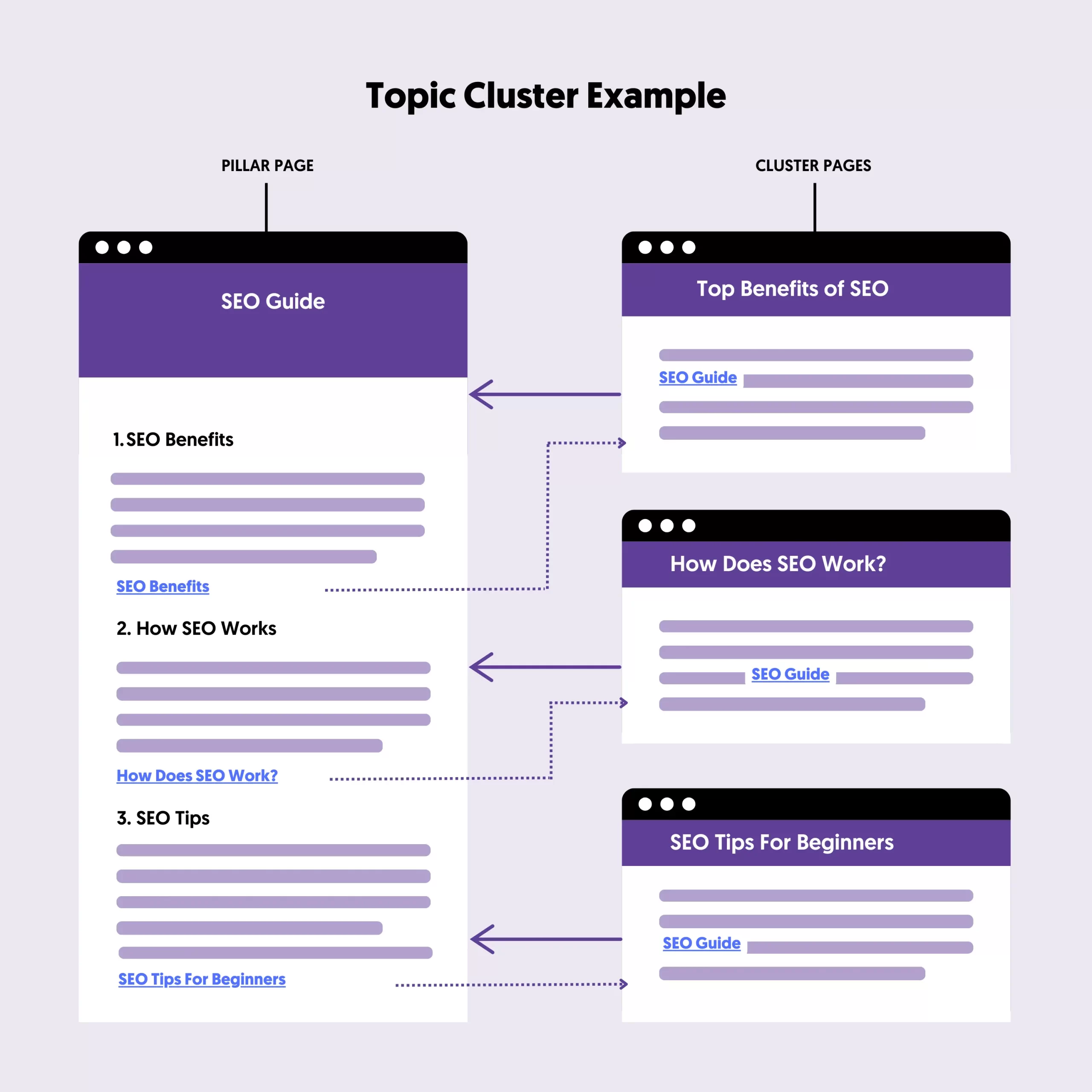
Here is the process to follow to build your topic clusters:
Choose a topic
Choose a topic you want to get high rankings from your list of primary keywords. This must be specific but broad enough to create several pages around it. For example, "dog food". It's a topic with a high search volume, suitable for a pillar page. It has a specific intent, and you can rank for many keywords with cluster pages.
Do Keyword Research
The next step is to analyze your main keyword further and find candidates for targeting with your cluster pages. These are known as long-tail keywords. In simple terms, they are keywords with lower competition and a decent monthly search volume.
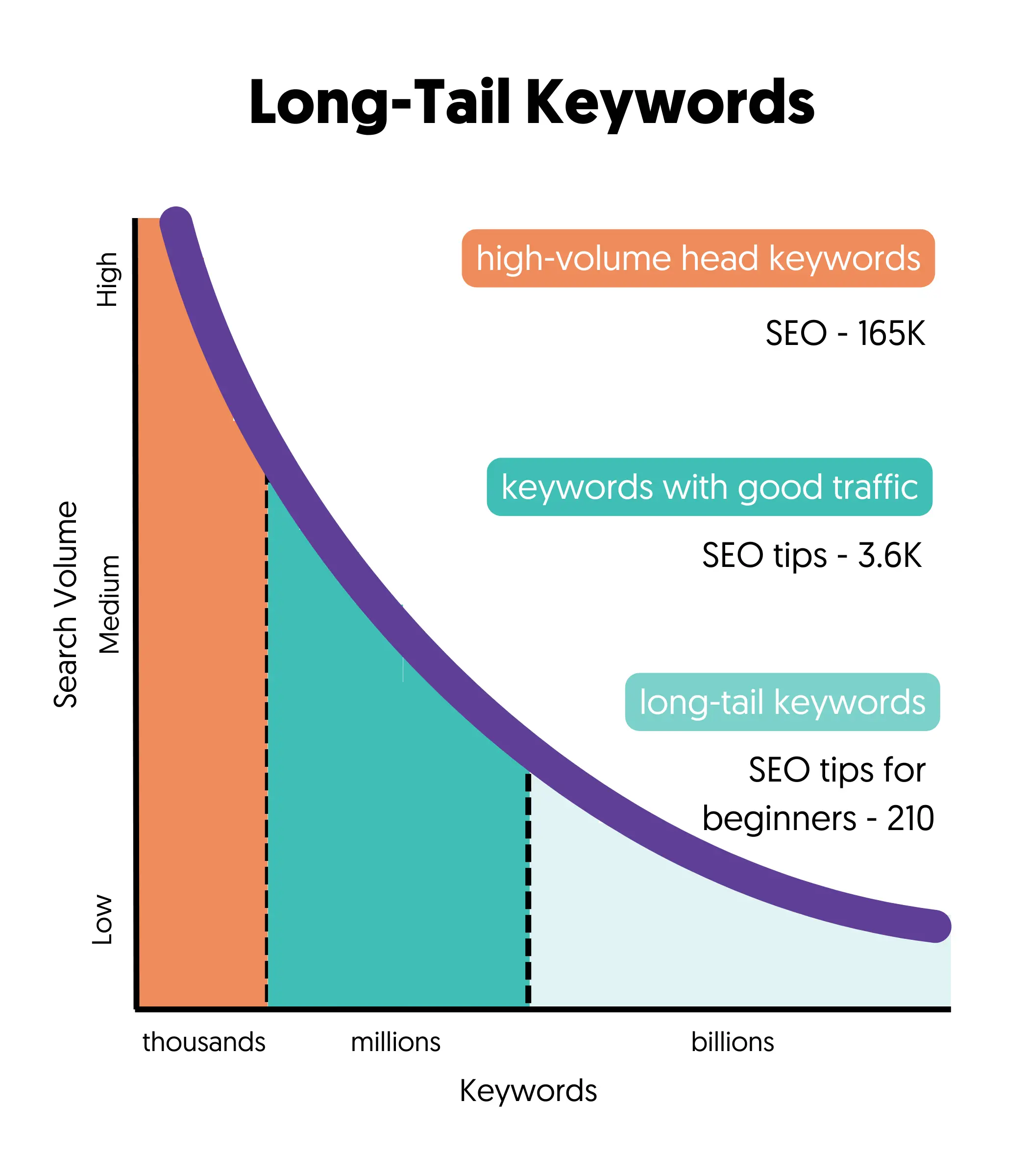
Here is the process to follow to find long-tail keywords:
Search Google using your target keyword and scroll down to the “People also ask” section and to the “Related Searches”.
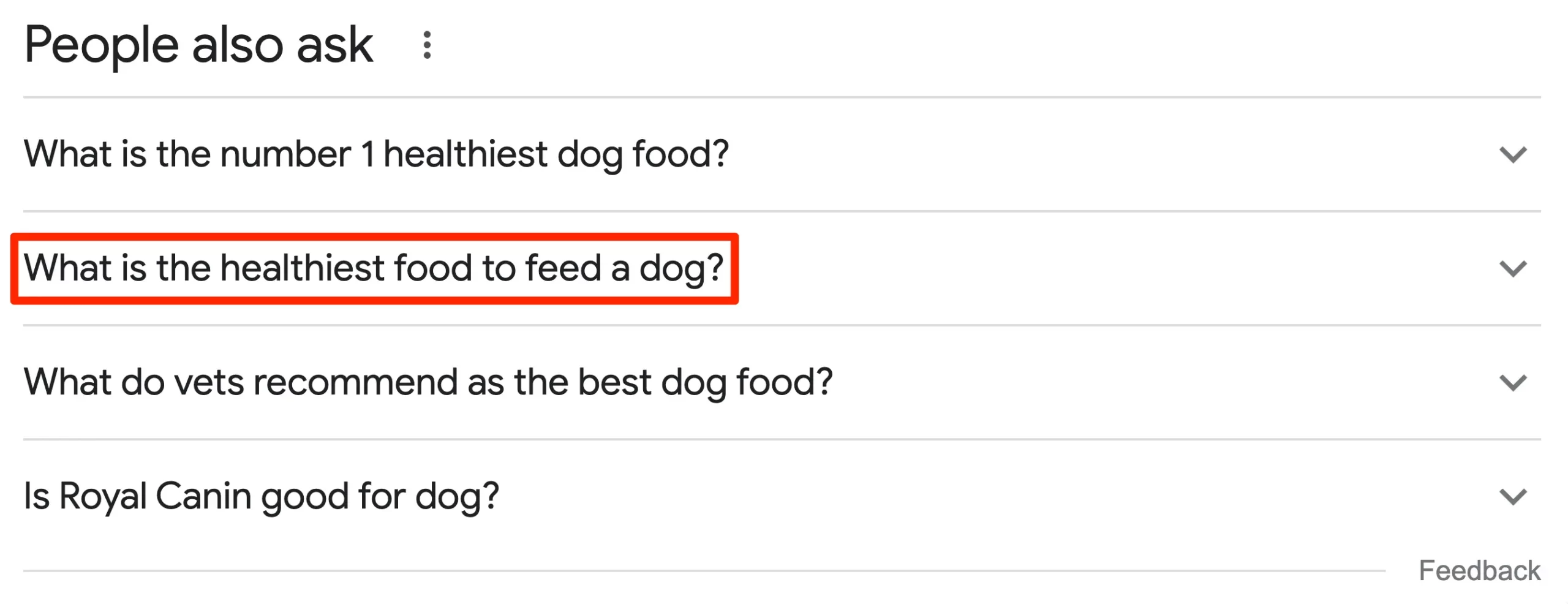
For example, if you enter “dog food” into Google, you get the following the ‘People also ask section’.
And this is in the ‘Related Searches’ section.
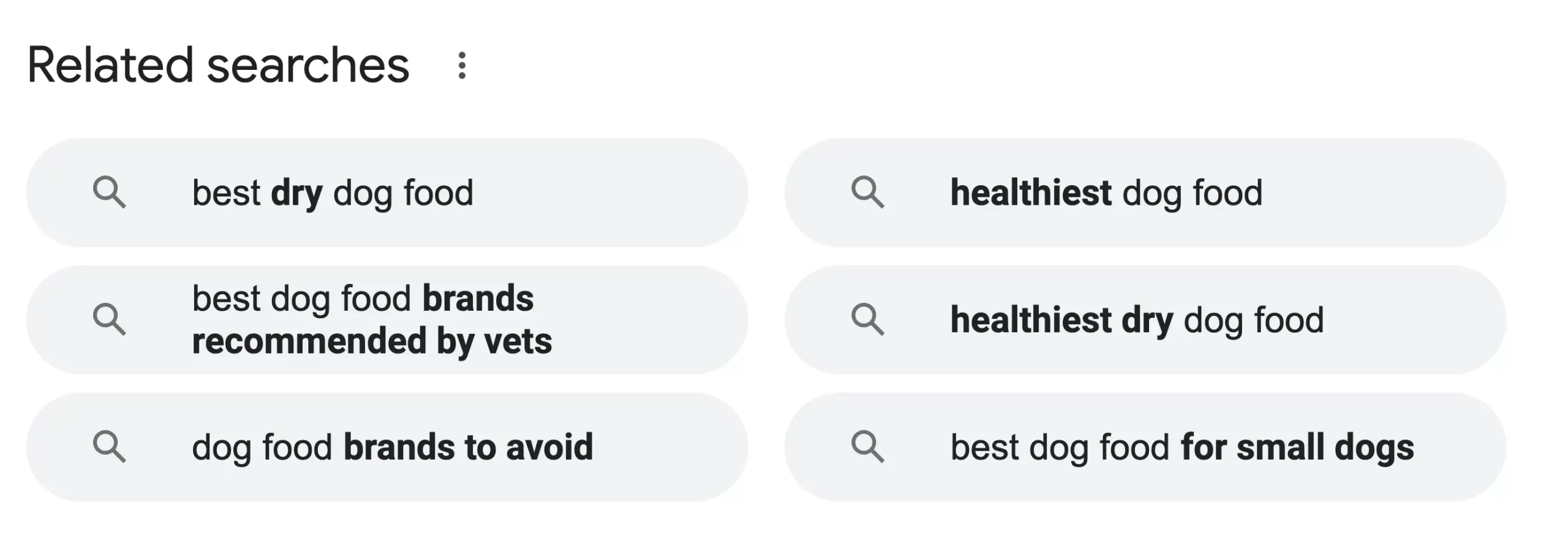
You can also use a keyword research tool to find long-tail keywords.
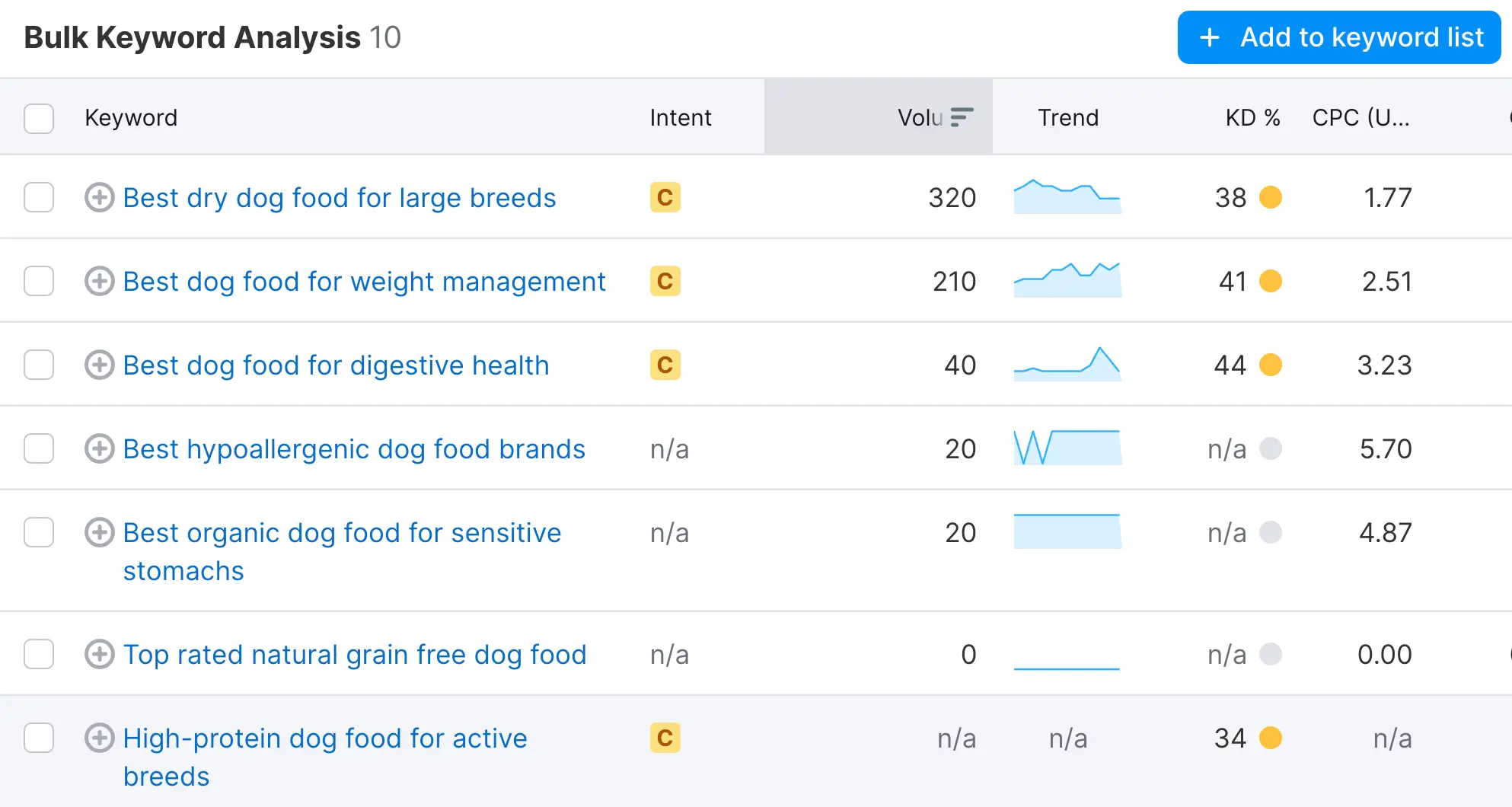
Create Your Topic Cluster
The final step is writing SEO-friendly content for your pillar and cluster pages and interlinking your pages together (as shown in the topic cluster diagram).
Here is a recap of steps to make it easier to understand.
- You create a pillar article for each high-traffic keyword important to your business.
- For each keyword, you also identify long-tail keywords.
- You create articles targeting long-tail keywords (cluster pages).
- Within the cluster articles, you link back to the pillar article and vice versa.
6. Optimize On-Page SEO
A critical element of a successful SEO strategy is on-page SEO. The primary goal of on-page SEO is to help search engines understand your content and its meaning.
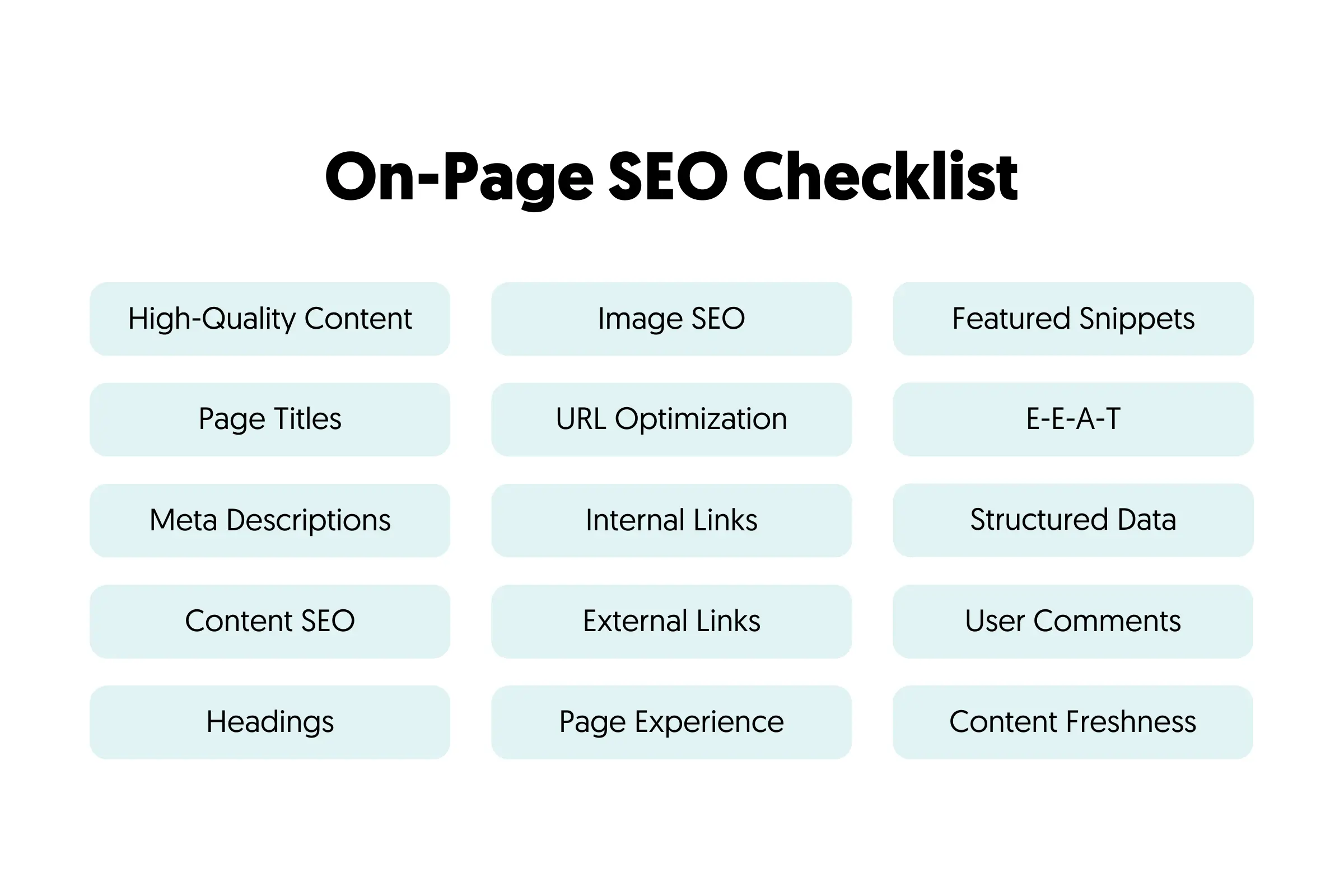
With on-page SEO, you deal with things like:
- Optimizing your titles
- Optimizing your meta descriptions
- Optimizing your H1 tag and headings
- Proper usage of keywords within the content of a page
- Image SEO and Video Optimization
- Efficient use of internal links
7. Perform A Content Audit
One of the secrets of steadily growing your organic traffic is to keep your existing content relevant and up-to-date. Once you get a good ranking for a keyword, you will not be guaranteed to keep this ranking forever. Hundreds of websites are targeting the same keywords, so you need to perform regular content audits.
A content audit is a process of analyzing every page of your website and deciding whether:
- To remove content
- Improve content
- Merge content
- Keep content as is.
Start By Finding 'unhelpful content'
The overall goal of a content audit is to make a website stronger by eliminating pages that are considered unhelpful content. Google's recent algorithmic updates go after websites with many pages of unhelpful content.
- To identify pages with unhelpful content, evaluate each page's engagement metrics, such as bounce rates, time spent on a page, and conversion rates. Pages with high bounce rates and low engagement may not meet users' needs.
- Assess the content quality: Is it providing value, is it original, and does it serve a specific user intent?
- Cross-reference these insights with Google's Helpful Content System Guidelines, emphasizing content created primarily for users, not search engines.
- Look for pages that might be overly optimized for SEO, lacking depth, or not offering a satisfying answer to what users are searching for.
These are strong indicators of content that may need improvement, merging, or removal to align with a user-first approach and enhance your site's overall quality in the eyes of search engines.
Update Your Top-Ranking Pages
Regularly updating your top-ranking pages is crucial for keeping your current traffic. Go back to step 2 (SEO Performance Analysis) and identify pages that drive the most Google traffic and have the highest engagement rates and conversions.
Ensure their content remains fresh, informative, and aligned with the current search intent.
Analyze if new, relevant keywords can be incorporated to capture additional search traffic. You can use the Search Results Report in Google Search Console to find the exact keywords a page is ranking and see if there are any missed opportunities.
To do this, go to Search Results Report, click the + button, and select Page.
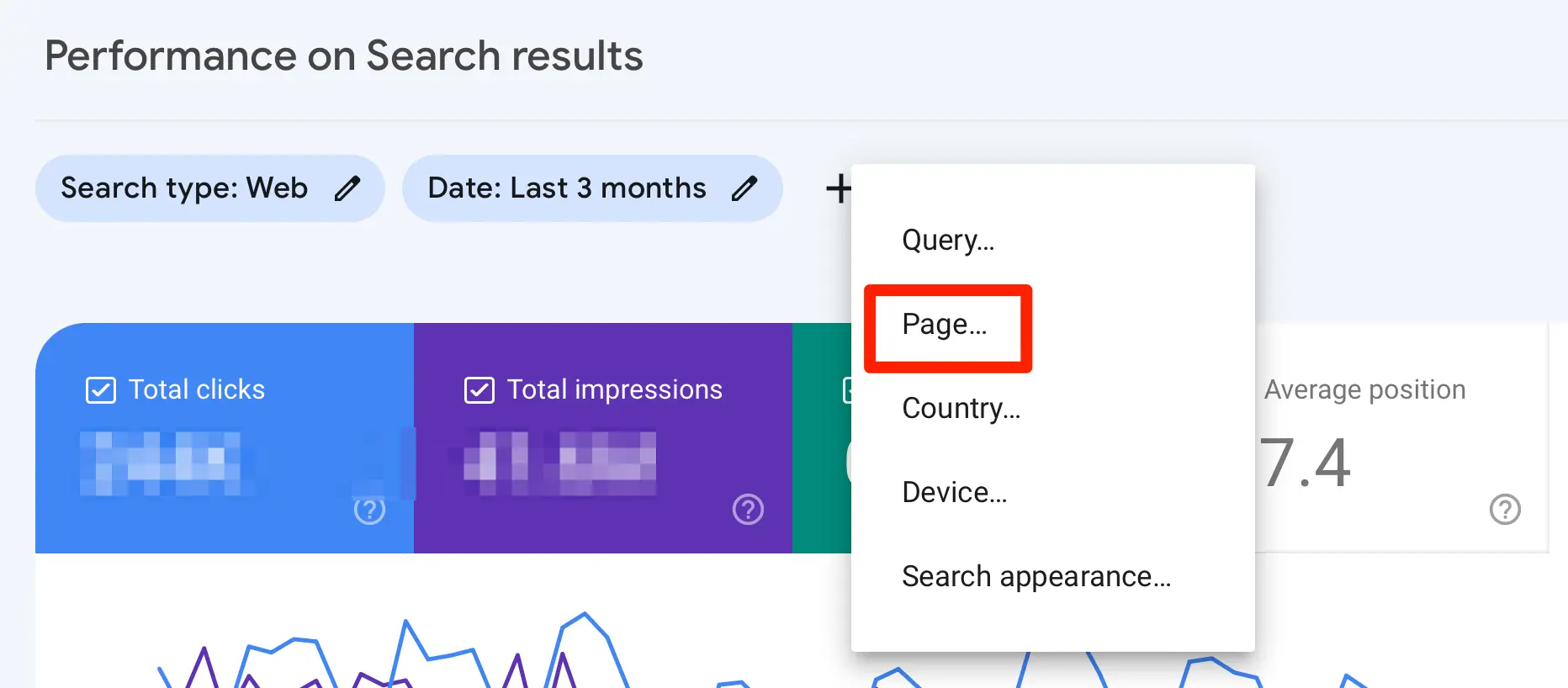
Look at the impressions and average CTR column. Spot any keywords your page ranks but are not mentioned in the content. Adjust your content to include those keywords naturally.
Lastly, consider the user experience. Simple tweaks like improving page load times, enhancing mobile responsiveness, and refining the content layout can significantly impact user engagement and SEO performance.
Improve Pages Ranking In Positions 4 to 10
Pages that rank in positions 4 to 10 hold significant potential to climb higher on the search engine results pages (SERPs). Improving these pages can substantially increase your visibility and traffic, as the top three positions in Google attract the most clicks.
Begin by analyzing why these pages are not in the top three spots. Look at factors such as content depth, topics covered, and backlink profiles compared to the higher-ranking competitors.
Optimize the content by ensuring it comprehensively covers the topic and answers related queries. This better serves the user’s search intent and positions your page as a candidate for Google featured snippets.
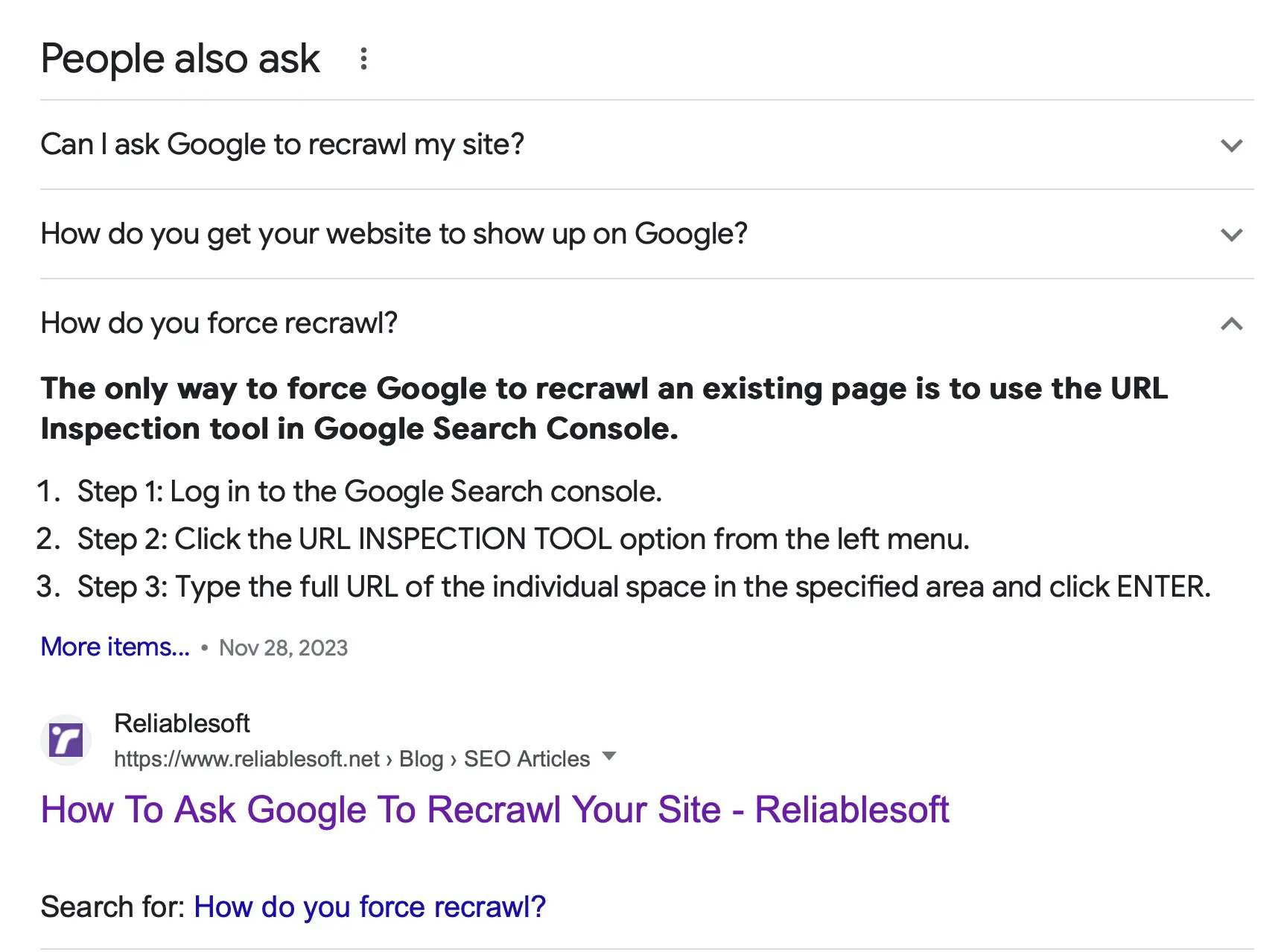
Optimize for featured snippets by providing clear, concise answers to commonly asked questions related to your topic, and format your content with structured data when appropriate.
As general advice, when doing a content audit, don’t be afraid to remove content from your website if it’s not up to your desired standards. Having fewer but higher-quality pages is better than having many low-quality pages.
8. Focus On Link Building
If you have reached this point, it’s time to deal with off-page SEO. Off-page SEO refers to SEO techniques that go beyond the website's content. The most important strategy is link-building.
Getting references from other websites will positively influence your rankings as these are considered 'votes of trust' by search ranking algorithms.
You should pursue two kinds of references: brand mentions and backlinks.
Brand Mentions
A brand mention doesn’t necessarily include a link back to your website. It can happen in any online medium, like Facebook, Reddit, and other social networks. The link (if any) can be nofollow.
How can "linkless mentions" help rankings?
Search engines can identify brand mentions, which translates to stronger site authority. It’s not as powerful as high-quality links, but it’s a factor considered by all major search engines, including Google.
Here is a quote from Gary Illyes (Google Employee), who mentioned the effectiveness of brand mentions several times.

What does this mean for your SEO Strategy? Four things:
- You need to track all kinds of brand mentions and try to increase them
- You must expand your strategy and go after brand mentions, not just links.
- Social media networks and guest posting on high-authority websites are great places to start.
- Run an outreach campaign to convert brand mentions to links.
Backlinks
I know from experience that getting high-quality backlinks is one of the most complicated areas of SEO. The thing is, you need to get links if you want to get TOP rankings for your target keywords.
This is how it works: Great content can get you to the FIRST page of Google, BUT great content with good incoming links from other websites can get you to the TOP positions of Google.
Do you see the difference? You don’t necessarily need backlinks to have a presence on the first page of Google, but you need links to get to the top.
How can you get high-quality links?
In general, there are three ways to get backlinks:
Natural Link Building - Creating content that naturally attracts backlinks is an essential tactic for a winning SEO strategy.
Focus on generating high-quality, informative, and unique content that positions your website as an authority in your niche. Publish case studies, original research, and other content to get the attention of other websites in your niche.
Leverage press releases and paid social media ads to promote your link-worthy content in front of the people more likely to link to it.
Building Links - Actively pursuing link-building opportunities can significantly enhance your backlink profile.
Consider guest posting on reputable websites within your industry. It's a great opportunity to showcase your expertise and earn valuable backlinks.
Additionally, utilize platforms like HARO (Help a Reporter Out) to offer your expert insights to journalists. In return, you get mentioned in their publications, earning high-quality backlinks from authoritative news sites.
Collaborations - Collaborating with other websites, especially those within your niche, can be a mutually beneficial way to build backlinks.
Reach out to related websites and propose collaborations that offer value to both parties. This could be by co-authoring a comprehensive guide, conducting joint webinars, or creating collaborative studies.
Ensure that the collaboration feels natural and provides substantial value to the audience of both parties, as this increases the likelihood of earning a backlink.
Improve Your SEO Strategy
There are many more ways to improve your SEO strategy. Consider enrolling in an SEO course to get a holistic view of all SEO strategies. Online courses can help you learn basic and advanced SEO practices structurally. Some courses come with an SEO certification to use in your CV.
A good example is The Complete SEO Course, but you can get more free and paid options here.



